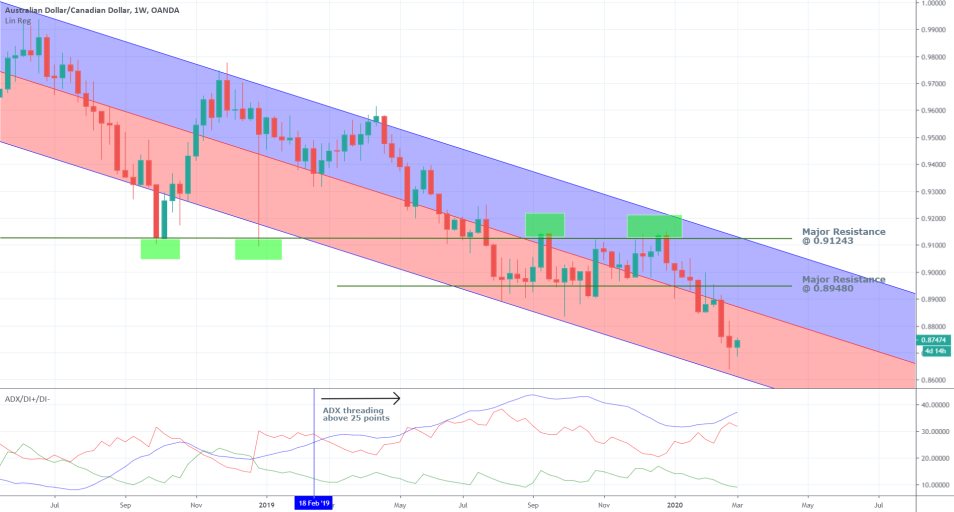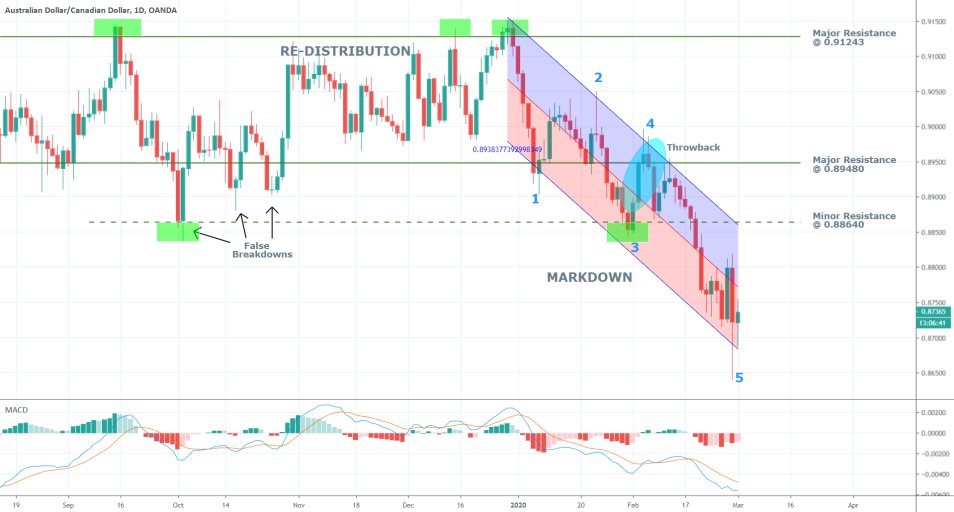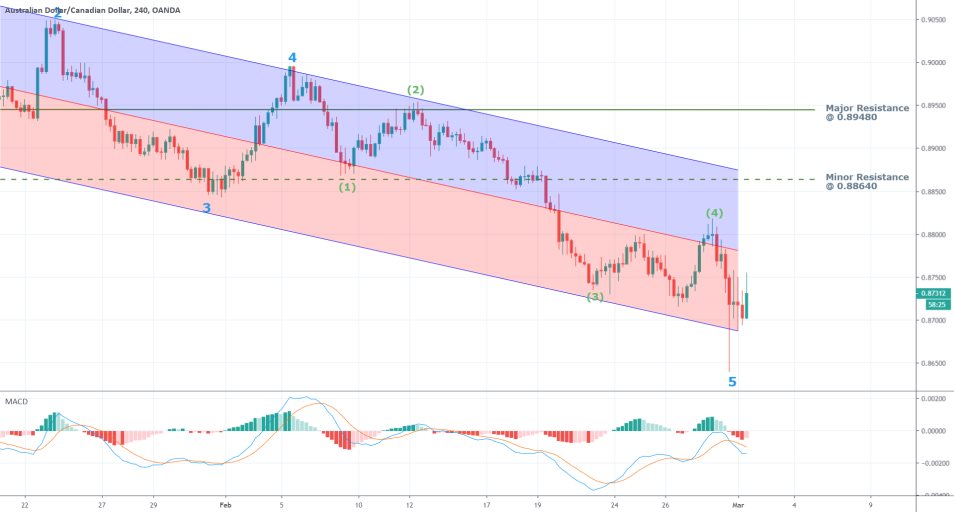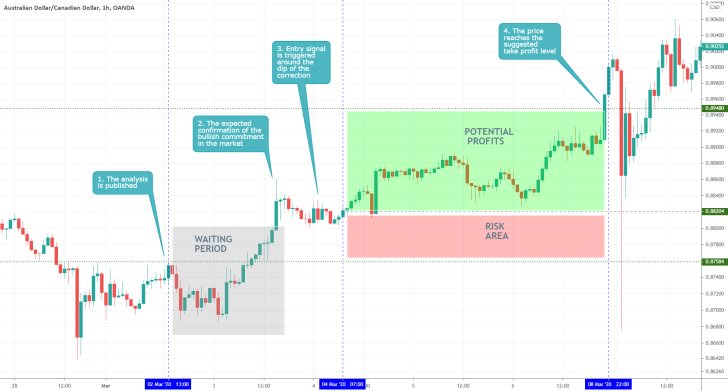The AUDCAD has been trading in a sweeping bearish trend for the past several months, and the underlying market pressures that have prompted its development are quite decisive. The recent developments concerning the spread of the coronavirus have only made the situation gloomier for the Aussie, which was already reeling from the trade war between the US and China.
That is so because Australia is quite dependent on the well-being of the Chinese economy and the normal functioning of the international supply networks. Both are damaged due to the distortions caused by the outbreak of COVID-19, which has had a rippling effect on the Australian economy.
Even so, the underlying situation is not desperate. The Reserve Bank of Australia is scheduled to hold a monetary policy meeting on Tuesday, and the Bank of Canada will do the same on Wednesday. The two central banks' interest rate decisions are almost certainly going to prompt even more volatility than the one that is currently underpinning the AUDCAD's price action, which consequently creates some quite exciting trading opportunities.
At present, bears seem to believe that the underlying trend is going to continue deepening. In contrast, contrarian traders and optimistic bulls believe that the AUDCAD, which is threading in a historically low territory, is now at a turning point, and that the two interest rate decisions from this week are likely to prompt a new bullish upswing.
The purpose of the current analysis is to weigh in on the two schools of thought and to highlight the most likely outcomes of the two monetary policy meetings to establish the next direction in the development of the AUDCAD. The analysis is going to be carried out in light of the ongoing coronavirus situation and the recent promise of central banks to accommodate the global economy in a bid to curb the negative impact of the virus.
1. Long-Term Outlook:
One of the most common reasons as to why traders expect a change in the direction of the market is the fact that last week the AUDCAD closed at the historic low at 0.87212, which was last reached in mid-July 2010. The bearish price action is now testing the decade-long support and optimistic bulls expect its sheer longevity to be enough to disrupt the current downtrend and prompt a new bullish upswing.
The price action of the pair has been trading above 0.87212 for more than ten years, which makes the historic support also a prominent psychological level. Yet, the durability of the current bearish trend should not be underestimated as well.
The Average Directional Index on the weekly chart below demonstrates that the AUDCAD's downtrend had become considerably strong in February 2019. Since then, the ADX has been threading above 25 index points, which confirms the perseverance of the downtrend.
The durability of the current downtrend juxtaposed against the psychologically important historic low that the underlying price action is currently trading around, are the two contrasting reasons that reassure traders that the AUDCAD is presently at the crossroads. It can either continue to dig deeper, or this week's two interest rate decisions could alleviate some of the pressure off the pair and prompt a new bullish spike.

The price is currently consolidating at the lower part of a linear regression channel. It is important to note that the major resistance level at 0.89480 became prominent when the price broke down below it and at the same time below the regression channel’s middle line. This means that any potential upswings would have to test the significance of the resistance level before they can be confirmed as being major bullish trends.
2. Time for the RBA and the BOC to Step in:
This week began with a volley of promising statements by central banks worldwide, as they appear to be stepping up on their efforts to accommodate the reeling global economy. By implementing even more accommodative monetary policy stances, the most prevalent central banks can alleviate the external pressure that is being caused by the coronavirus panic and stimulate the general economic activity. As regards the AUDCAD, the most important considerations should be made on the perceived impact of the RBA and BOC’s interest rate decisions this week.
- In Australia. The Governing Board of the RBA is meeting early on Tuesday morning to discuss the current monetary policy and the impact of the coronavirus panic on the muted demand in Australia. Arguably, the central point of the discussions is expected to be the perceived negative impact of the COVID-19 on the industrial activity in China, and how the Board of Governors expects it to affect the economic processes in Australia.
The last monetary policy gathering was held on the 4th of February when the Board of Directors made only two references to the impact of the coronavirus:
“[…] Another source of uncertainty is the coronavirus, which is having a significant effect on the Chinese economy at present. It is too early to determine how long-lasting the impact will be. […] In the short term, the bushfires and the coronavirus outbreak will temporarily weigh on domestic growth.”
The overall tone of the previous monetary policy statement was mostly optimistic, with RBA officials expecting the Australian economy to continue growing at a moderate pace in the mid-term. That is why the consensus forecasts for tomorrow’s meeting do not expect a change in the underlying interest rate to be introduced, which is currently at 0.75 per cent.
Nevertheless, the overall situation has changed drastically since the 4th of February, and the Board of Directors might be compelled to cut the interest rate in a bid to accommodate the reeling Australian economy and stimulate the muted demand.
Typically, lower interest rates are bad for the underlying currency, which loses its competitive strength. That is why the AUDCAD might extend its losses in the wake of the decision's release on Tuesday; however, this may not last for long.
Under the current circumstances, investors are likely to perceive a potential reduction of the interest rate by 25 basis points as a good thing for the economy, and by that extend as a good thing for the Aussie. Lower interest rates are going to make the underlying liquidity in the country even more pronounced, which, in turn, is going to be an even better incentive for the lift-off of the general economic activity.
At any rate, the most likely outcome from tomorrow’s meeting of the RBA is one in which the initial market reaction and the longer-term consequences have distinctly different charges and directions.
- In Canada. The Monetary Policy Committee (MPC) of the BOC is meeting on Wednesday in the afternoon, and the consensus forecasts project similar outcomes. The underlying interest rate in Canada is expected to be maintained unchanged at its current level of 1.75 per cent.
The impact of the coronavirus has been less pronounced on the Canadian economy, which seems to imply less need for the implementation of drastic measures by the BOC. Even still, the local economy has been hit by plummeting oil prices.
Canada is one of the biggest exporters of the commodity, which means that its Balance of Trade is dependent on the stability of the crude oil prices. And with the momentarily stunned commodities market, the Canadian economy might need more support by its central bank's monetary policy, similar to Australia.
At the current rate, the Bank of Canada does not seem as hardpressed to implement a more accommodative monetary policy unlike Australia, which means that it is more likely to remain vigilant without undertaking any profound structural changes. This would disadvantage the Loonie in the short-term, provided that the RBA does indeed reduce its own interest rate.
3. Short Term Outlook:
The daily chart below deconstructs the behaviour of the dominant bearish trend that was presented on the weekly chart above. It is shown that the price action has managed to establish a new minor Markdown after it broke down below the major resistance level at 0.89480, which acted as a lower boundary of the re-distribution range.

The markdown is represented as a wave pattern under the Elliott Wave Theory, which posits that any such patterns follow the characteristics of a 1-5 impulse wave. Thus, the markdown is expected to be terminated once the price action is proven to have reached a dip at 5 (this could very likely have happened already).
The MACD exhibits the strength of the bearish momentum; however, it can also be seen that the commitment of the downtrend is being exhausted. This would favour the formation of a potential bullish correction.
The most recent price action that took place over the last few trading days underpins the potential for a reversal in its direction. As can be seen, by the sporadic fluctuations that were initiated at the outset of last week's trading action, the markdown has begun to lack commitment as the coronavirus scare began to gain momentum globally.
Instead, the AUDCAD started to consolidate in a tight range in the lower part of the regression channel. The potential for a trend reversal is further supported by the huge lower-tail of one of the candlesticks, which exhibits uncertainty amongst bears and strong support.

The price action on the 4H chart above further supports the previous assertions. It is currently consolidating in a narrow range without a distinctly prevalent momentum in either direction.
If the price manages to break out above the middle line of the regression channel, it would be a strong indication that the market is ready to start establishing at least a minor bullish correction. Depending on the size and commitment of such a potential breakout, it would be further asserted whether the new market sentiment has the capacity to prompt something more considerable than a simple correction, such as a new bullish trend.
4. Concluding Remarks:
Because of the massive levels of volatility that are anticipated to hit the AUDCAD price action starting Tuesday, proactive trading is not recommended. Furthermore, the likelihood of adverse fluctuations immediately following the release of RBA’s interest rate decision tomorrow is additional evidence that traders would do well to wait and see how the market develops next.
Trading on the expectation for the formation of a trend reversal (or at least a new bullish correction), should be done only if the initial breakout above the regression channel’s middle line on the 4H chart is considerable enough to demonstrate a strong commitment on the market. Small and undecided breakouts with huge upper-shadows will not suffice.

- The trade was successful in the sense that it fulfilled the initial goal of the analysis – reactive trading following the publication of major economic data (RBA's decision). The grey area illustrates the waiting period as a long order was placed only after the confirmation of the bullish bias was received. However, this should not be considered as a missed opportunity, because the original idea was to hedge against the possibility of a negative market reaction (to the news). The risk was handled properly, even if the eventual profits were lesser than what they could have been. For more risk-averse traders, it is better to accept smaller profits if they can somehow mitigate the underlying risk.
Disclaimer: Your capital is at risk! Trading and investing on the financial markets carries a significant risk of loss. Each material, shown on this website, is provided for educational purposes only. A perfect, 100% accurate method of analysis does not exist. If you make a decision to trade or invest, based on the information from this website, you will be doing it at your own risk. Under no circumstances is Trendsharks responsible for any capital losses or damages you might suffer, while using the company’s products and services. For more information read our Terms & Conditions and Risk Disclaimer.





















